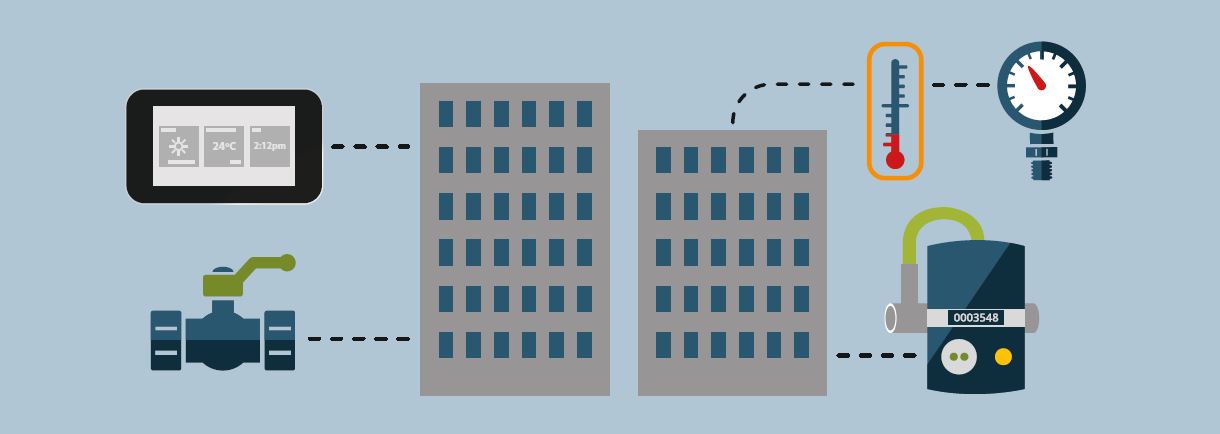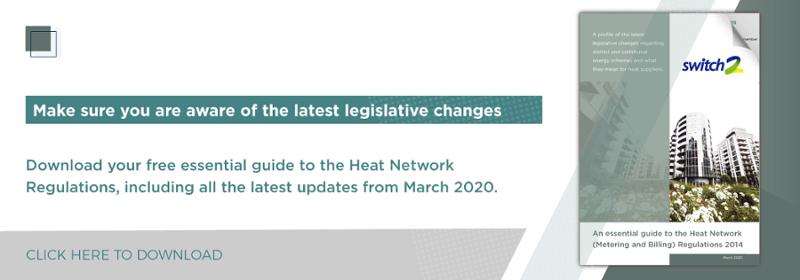Ian Allan, Head of Strategy for Switch2 Energy, offers guidance on the steps communal heating suppliers must take to comply with the updated Heat Network (Metering and Billing) Regulations (HNMBR).
The regulations, which stem from the EU Energy Efficiency Directive, are applicable to most sites that distribute thermal energy for heating, cooling or hot water from a central source to more than one end user, building or location. Legislation is enforced by the Office for Products & Safety Standards (OPSS).
Regulations are currently being updated as part of the Heat Network Market Framework. One of the most significant areas of consultation is a requirement to retrofit final customer meters to non-metered homes, where a revised new feasibility tool shows that it is viable. Other proposals include extending provisions on meter accuracy, maintenance and billing.
It is critical that heat suppliers comply with HNMBR – not just to avoid civil and criminal penalties – but to raise network performance and improve customer service. The regulations drive best practice in smart metering and billing. This pays off in terms of improved heat scheme efficiency, emissions reductions and better customer service. Real-time data from metering informs overall heat network efficiency and generates major performance improvements.
As the UK accelerates the roll-out of heat networks across towns and cities, the regulations remain key to the difficult challenge of reducing CO2 emissions from space heating and are unlikely to be affected by Brexit.
There are 3 key requirements of HNMBR
- Notification
Heat suppliers must inform the OPSS about the location of any heat network or communal heating scheme - as well as its capacity and supply figures. Each building that forms part of the network must also be identified, along with the number of customers using it and details of the billing information they receive.
Registrations must be updated (using the updated notification template) every four years. Since most heat networks registered by the original notification deadline of December 2015, they should have re-notified by 31 December 2019, but it is believed that many of the UK's 17,000 heat network operators failed to respond to this deadline. The OPSS has begun issuing formal warnings to these non-compliant heat networks.
- Metering
a. Point of entry meters
It is mandatory for all communal heat schemes (with more than one building supplied with heat) to install point of entry meters, or bulk meters, which record the amount of heat delivered into a property from the plant room or energy centre.
b. Final customer meters
It is also mandatory to install final customer meters on new builds and most buildings undergoing major renovation. If these meters are not feasible, the viability of heat cost allocators must be considered. The meters require scheduled servicing alongside periodic recalibration of heat cost allocators.
The requirement to fit final customer meters at existing non-metered properties is not yet compulsory, but this is likely to change soon. Consultation is currently underway as part of the Heat Network Market Framework, including proposals for a revised new feasibility tool, which will determine the viability of retrofitting final customer meters to non-metered homes.
This will replace the original tool, which was suspended in 2015 and has now been re-designed. When the new tool is released, heat suppliers with non-metered networks will have to test the scheme to determine whether it is viable to install meters or heat cost allocators and then take any required corrective action. This test must be repeated every four years and it is expected that all heat networks will need to be fully metered over time.
- Billing
End customers must be billed using actual meter readings (rather than estimates) at least once a year. Those customers receiving bills electronically should, however, be invoiced quarterly. At a minimum, bills must contain current energy prices, details of total consumption (compared to the previous year, if applicable) and general information on how to improve energy efficiency.
The legislation imposes duties on the heat supplier, but OPSS has issued guidance on how these responsibilities may be shared between billing managers and network managers or owners, subject to discussions on who is best placed to undertake these duties.
Simplifying compliance
Innovative new pay-as-you-go (PAYG) smart meters can simplify the compliance process and drive behavioural change by giving customers full visibility of how much energy they are using and how much it's costing them. This leads to significant cost and carbon savings.
In our experience, where we have installed smart metering and pay-as-you-go billing, heat usage has been reduced by up to 50%, compared to unmetered dwellings.
OPSS has confirmed that PAYG systems are compliant if:
- Billing information is available on the PAYG unit at any time
- The PAYG unit has an approved in-home display feature
- Meter readings are available on the unit
- An annual billing statement is provided to customers



